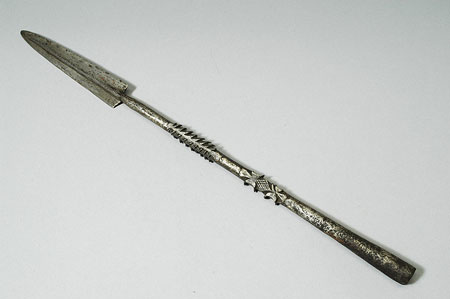Accession Number:
1942.8.58
Country:
?Sudan
Region:
?Kordofan ?Darfur
Cultural Group:
?Zande
Date Made:
By 1891
Materials:
Iron Metal
Process:
Forged (Metal) , Hammered , Socketed , Decorated , Incised
Dimensions:
L = 386, blade L = 120, W = 23.3, th = 5; upper shank diam = 8.7, barbed section W = 11.3, th = 10.7, socketed base diam = 15.1 x 14.8 mm [RTS 27/6/2005].
Weight:
171.1 g
Other Owners:
Bought in Egypt in 1891, collector unknown; entered in PRM records as a donation of Henry Balfour for convenience
PRM Source:
?Henry Balfour
Acquired:
?Donated August 1942
Collected Date:
1891
Description:
Iron spearhead consisting of a narrow blade with rounded tip and straight sides gradually tapering out to almost straight shoulders at its base.
This has a raised midrib running down the centre of both sides, and an ogee-shaped section.
It merges with a long shank that is round in section, except for 2 sections part-way down the body where the surface has been flattened to make the section square.
The first of these has been worked along each edge to create a series of downward pointing barbs, chiselled and pulled out from the surface, with a shallow line incised around the shank below.
The lower section has been framed by incised lines above and below, then a series of 4 barbs created along each edge, by punching 4 oblique chisel blows down the side in alternating direction.
This has created x-shaped pairs of barbs, the edges of which were then partially hammered closer to the shank body.
Several of this group of barbs may have lost their tips.
There is a flat, lozenge-shaped section of the shank surface in the centre of these groups on each side that has been used as a surface for further decoration.
On one face, this consists of 2 incised < and > shaped motifs with a straight line between; the opposite face was decorated with pairs of lines framing the sides of the lozenge.
Below this area, the shank becomes round again and turns into a socket that gradually expands towards its base.
This has a closed seam running down the front.
The spear is complete, except for possible damage to the barbs described above, and currently a metallic light gray colour (Pantone Warm Gray 1C), with some yellowish surface coloration from a former conservation treatment.
It has a weight of 171.1 grams and is 386 mm long; the blade is 120 mm long, 23.3 mm wide and 5 mm thick; the upper part of the shank has a diameter of 8.7 mm; the barbed section is 11.3 mm wide and 10.7 mm thick, and the socketed base has a diameter of 15.1 by 14.8 mm.
Bought in Egypt in 1891; the original collector's name was not recorded. The style of this object suggests that an origin in either Darfur or amongst one of the Nilotic groups of the Southern Sudan is quite possible; there are some similarities to the style of Shilluk fishing spearheads 1942.8.61 and 1961.9.8.
Rachael Sparks 30/9/2005.
Bought in Egypt in 1891; the original collector's name was not recorded. The style of this object suggests that an origin in either Darfur or amongst one of the Nilotic groups of the Southern Sudan is quite possible; there are some similarities to the style of Shilluk fishing spearheads 1942.8.61 and 1961.9.8.
Rachael Sparks 30/9/2005.
Primary Documentation:
Accession Book Entry
- [p.
125, August 1942]
The late Henry Balfour, F.R.S.
, Miscellaneous specimens found unlabelled, entered for convenience as donations of the late Curator.
[p.
135] 1942.8.58
- Socketed iron spear-head, small [Drawing of blade] -shaped blade, with midrib, barbed and ornamented shank.
Same data.
[as 1942.8.56 = "Probably ANGLO-EGYPTIAN SUDAN (? NUBIA, KORDOFAN, DARFUR, possibly also from further west; HAUSA, or further South: ZANDE, MANGBETU)."]
Card Catalogue Entry - There is no further information on the catalogue card [RTS 28/1/2004].
Pitt Rivers Museum label - Socketed spear-head with barbed shank. ?ANGLO-EGYPTIAN SUDAN. Bought in EGYPT, 1891. 1942.8.58 [rectangular metal-edged tag, tied to object; RTS 24/6/2005].
Related Documents File - In the Related Documents File is a list detailing: "Donors, or probable donors, of material entered under Mr. Balfour's name. ... 1942.8.56-61. No suggestion. (Bought in Egypt, 1891)" [MR 10/5/2000].
Card Catalogue Entry - There is no further information on the catalogue card [RTS 28/1/2004].
Pitt Rivers Museum label - Socketed spear-head with barbed shank. ?ANGLO-EGYPTIAN SUDAN. Bought in EGYPT, 1891. 1942.8.58 [rectangular metal-edged tag, tied to object; RTS 24/6/2005].
Related Documents File - In the Related Documents File is a list detailing: "Donors, or probable donors, of material entered under Mr. Balfour's name. ... 1942.8.56-61. No suggestion. (Bought in Egypt, 1891)" [MR 10/5/2000].





